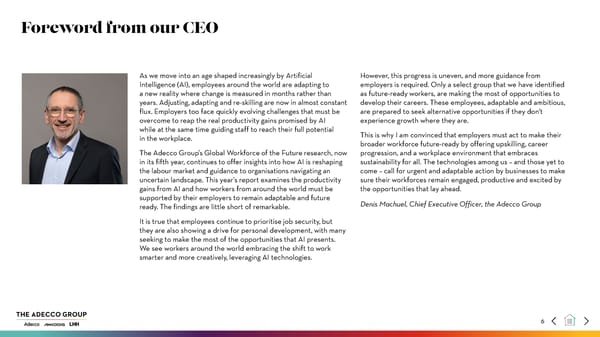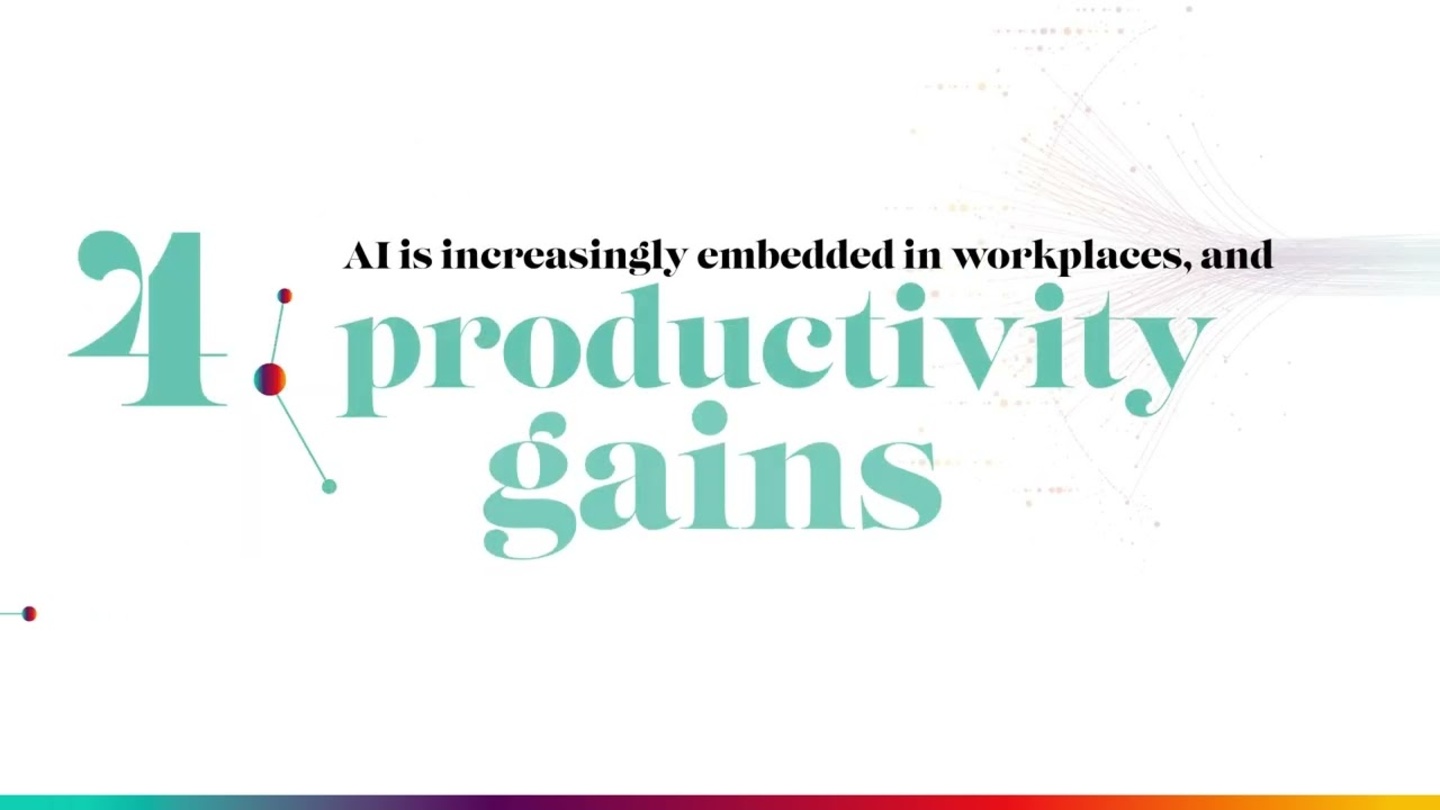2024 | Working Through Change
Adapting to an AI-Driven World of Work.
Working through change Adapting to an AI-driven world of work
Contents - About the research - Foreword from our CEO - Key findings Section one: Employers have a responsibility to prepare their workers Section two: Employers must upskill a generation of future-ready talent Section three: Workers want internal mobility, but employers fail to see the value Section four: AI impact reveals high-value human potential Section five: Build trust in AI to enable every employee to do their best work - Recommendations - Appendix 2
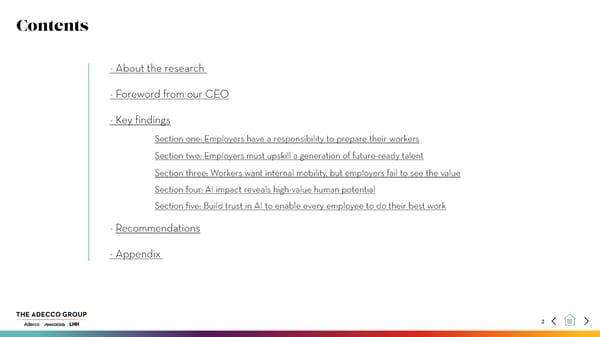
About the research Now in its fifth year, the Global Workforce of the Future research investigates the changing world of work from the perspective of workers. This year, our research focuses on how to work through change and the impact on work of artificial intelligence (AI). This report provides guidance to organisations seeking to develop an adaptable and future-ready workforce. The Adecco Group surveyed: 35,000 workers across 27 countries Americas (9,555) EMEA (17,405) APAC (8,040) Fieldwork was conducted in July and August 2024 in local languages Argentina 1000 Belgium 500 Poland 505 Australia 2000 via an online, self-administered survey lasting 20 minutes on average. Denmark 385 Portugal 1000 China 2000 Brazil 1000 The data is representative with a confidence interval level of 95%, Canada 1025 Finland 505 Romania 500 India 2030 and quotas were set to ensure a national representative sample by Japan 2010 age and gender in each country. Mexico 1000 France 2025 Slovenia 360 . USA 5530 Germany 2025 Spain 2025 For more demographic information, please see the appendix Greece 500 Sweden 505 Italy 2025 Switzerland 1005 Netherlands 500 Turkey 505 Norway 505 UK 2030 3
Meet our respondents Nationally representative across age and gender % Respondents with supervisory responsibilities 60 account for three-fifths of the sample Employed at the time of survey, across a wide 38% Two-fifths of respondents are agency workers range of sectors Represent a wide range of job functions, % Respondents are mostly white-collar workers across 29 categories 84 (84% vs. 13% blue-collar workers*) % One-fifth of respondents are Smart Industry 20 workers^ Respondents are mostly employed full time % (35+ hours a week vs. 13% employed part time, 87 up to 35 hours a week) *Blue-collar, e.g., manual labour or skilled trades; white-collar, e.g., office based, professional or administrative. We do not include in either white-collar or blue-collar groups employees who work in service-oriented or caregiving professions, such as nursing, teaching and retail. 4 ^Smart Industry workers are defined as those who work in design, development and/or engineering in certain roles (see Appendix for more detail).
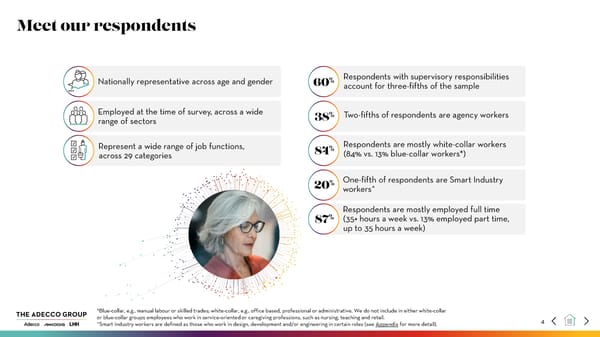
Foreword from our CEO
Foreword from our CEO As we move into an age shaped increasingly by Artificial However, this progress is uneven, and more guidance from Intelligence (AI), employees around the world are adapting to employers is required. Only a select group that we have identified a new reality where change is measured in months rather than as future-ready workers, are making the most of opportunities to years. Adjusting, adapting and re-skilling are now in almost constant develop their careers. These employees, adaptable and ambitious, flux. Employers too face quickly evolving challenges that must be are prepared to seek alternative opportunities if they don't overcome to reap the real productivity gains promised by AI experience growth where they are. while at the same time guiding staff to reach their full potential This is why I am convinced that employers must act to make their in the workplace. broader workforce future-ready by offering upskilling, career The Adecco Group’s Global Workforce of the Future research, now progression, and a workplace environment that embraces in its fifth year, continues to offer insights into how AI is reshaping sustainability for all. The technologies among us – and those yet to the labour market and guidance to organisations navigating an come –call for urgent and adaptable action by businesses to make uncertain landscape. This year’s report examines the productivity sure their workforces remain engaged, productive and excited by gains from AI and how workers from around the world must be the opportunities that lay ahead. supported by their employers to remain adaptable and future Denis Machuel, Chief Executive Officer, the Adecco Group ready. The findings are little short of remarkable. It is true that employees continue to prioritise job security, but they are also showing a drive for personal development, with many seeking to make the most of the opportunities that AI presents. We see workers around the world embracing the shift to work smarter and more creatively, leveraging AI technologies. 6
Key findings Employers have a responsibility to Employers must upskill a generation Workers want internal mobility, prepare their workers of future-ready talent but employers fail to see the value Workers are worried about an uncertain future: With support from their employers, a minority group Are workers losing faith in their employers' commitment economic climate and job security are front of mind. of workers are outperforming the rest. Companies to their development? More employees want to see More are staying in their jobs, but AI's impact on must commit to skills growth to increase this segment internal mobility, but fewer are choosing to stay stability has been underestimated over the last 12 of their workforce and train future leaders. specifically to be upskilled. months and employees are looking for guidance. only of the sample are future-ready workers. say companies should train existing % are concerned about long-term % They are adaptable, willing to be flexible % employees for different roles across the 40 job security 11 with their career plans, and are proactive 76 organisation before hiring external about growing their skills candidates – up 12 points since 2023 plan to stay with their current % of future-ready workers are given a % Less than one in 10 plan to stay to be 83% employer -the highest figure in 93 personalised development plan from 9 reskilled for a job at their company - three years (up from 61% in 2022) their employer (vs 51% of all workers) a drop of 7 points since 2023 % have lost their jobs because of AI. % frequently participate in leadership % Only half of business leaders* say they 13 In 2023, just 8% of people were 95 training provided by their employer 52 have strategies in place to encourage worrying about this (vs 57% of all workers) internal mobility *The Adecco Group, April 2024, Leading Through the Great Disruption 7
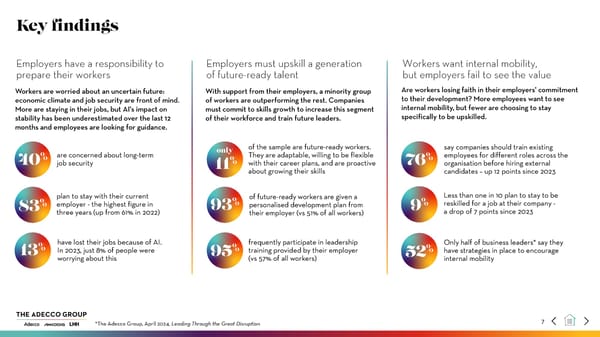
Key findings AI impact reveals high-value Build trust in AI to enable every human potential employee to do their best work As AI has become more embedded, organisations There's so much change happening in the workplace have been able to measure its impact on the that looking after employee mental health should be workforce –and they are uncovering productivity a priority for companies. They must address fears gains. Many workers now have more capacity for that AI will advantage certain worker groups and can creative or strategic work, but they need better do this by showing that they are committed to guidance to maximise their potential. inclusion and sustainable working practices. have felt burnout in the past 12 months from 1 is the average daily time saved from % working too hard, and this jumps to 62% of hour using AI 40 those who are concerned about the impact of AI and have been negatively affected by it % of those saving time using AI are % Less than half are confident that their leaders 28 spending it on more creative work 46 have enough AI skills and knowledge to understand the risks of AI adoption at work only have completed training on how to % value the human expertise of a recruiter to 25% apply AI at work 76 see potential in them beyond their skills and experience, up from 64% last year 8
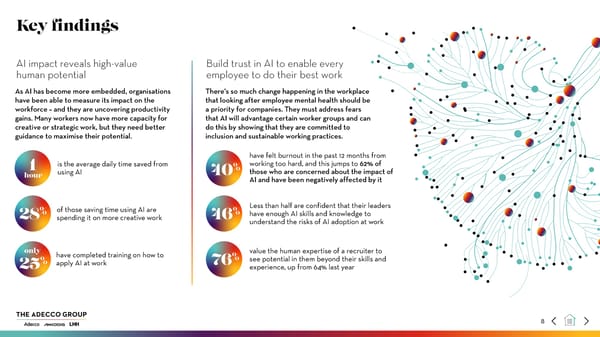
SECTION ONE Employers have a responsibility to prepare their workers
Summary The number of employees staying Workers are worried about an with their current company has Despite the cautious landscape, uncertain future. The economy and increased for the third year in a row. workers are proactive job security are major concerns, Many are trying to understand what about career progression. They especially because the impact of the future holds, and nearly half want to remain employable, and workplace AI is emerging. expect their employer to educate they see AI as an opportunity them more on the changing to develop in new directions. world of work. 10
“I believe that the combination of humans and AI will create more wonders in this world. Those who embrace AI will adapt and it will improve our workflow and innovative ideas.” Audio engineer, USA, Entertainment 11
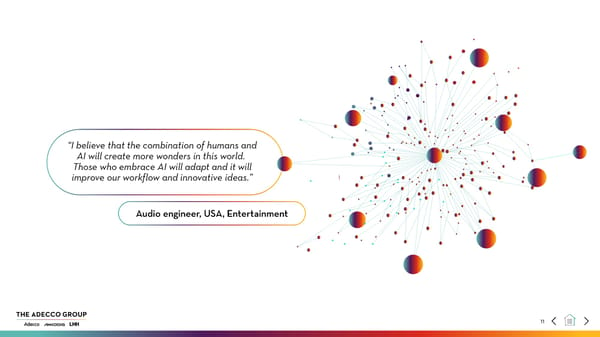
Economic uncertainty and job security fears are shaping the workplace Financial worries are having a big impact on workers: nearly half say economic uncertainty is front of mind, and job stability is one of their biggest concerns. Flexibility is the second biggest influence, but employees believe that for their company this is a lower priority than talent shortages and business uncertainty. Workers are clearly seeing a gap here between themselves and their leaders, which employers have a responsibility to address. Uncertain landscape: employees say the economy is having a major influence on their work outlook Economic uncertainty 32% 48% Flexible ways of working 25% 45% Digitisation 28% 35% Artificial Intelligence 30% 27% % Generative Artificial Intelligence 25% 29% 40 Talent scarcity or skills shortages 26% 40% Automation 26% 26% Business uncertainty 23% 38% of workers are concerned about Transition to a green economy 21% 29% “long-term job security” Geopolitical uncertainty 18% 29% Influencing my working life Influencing my employer ‘Which of the following megatrends have the most influence on your working life/on your employer?’ Q1 Which of the following megatrends have the most influence on your working life / on your employer | Q2 Thinking specifically about your current role and career prospects, 12 which of the following concern you the most?
Employees are grasping the reality of workplace AI Workers appear to have underestimated the real-world impact of AI. Twenty-three percent of people say that AI has made their skills less relevant – about double the proportion who expected this in 2023. And last year, only 8% of people feared that AI would make them lose their job; this year, 13% say it has. To avoid workers becoming fearful of AI, employers must be clear about its opportunities and transparent about the impact – both good and bad – that it could have on jobs. 2023 “AI will make my skills less “AI will force me to consider “AI will make sentiment relevant to the job market” a change of profession” me lose my job” % % % 12 11 8 2024 “AI has made my “AI has forced me to consider “AI has made reality skills less relevant” a change of profession” me lose my job” % % % 23 21 13 2023 CoreQ27 What impact will the following 'megatrends’ (AI) have on your job? | 2024 Q12: Do you agree or disagree with these statements about the impact of AI at work? 13
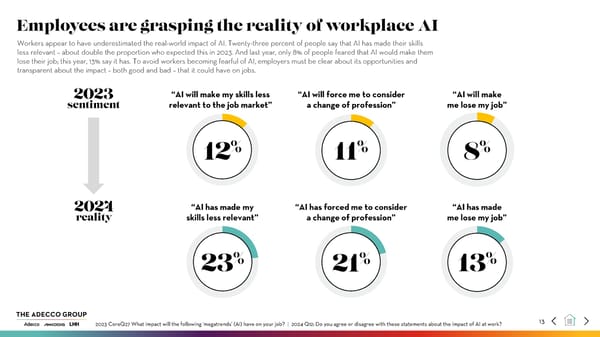
Employees are staying put until they get clarity aboutthe future of work The number of employees staying with their company has increased year on year since 2022 – perhaps a reflection of the uncertain work environment. Workers also want more direction from their employers on how their jobs might evolve: only one in five see it as their responsibility to educate themselves on the changing nature of work (a drop of seven points since last year), but nearly half say that this is their leader's or manager's job. Employers will have to give their workforce guidance on the changing nature of work and its opportunities. Highernumbers planto stay with their … and many feel less equipped than last year employer for the next 12 months… to educate themselves about the future of work 50% 48% 27% 61% 20% 76% 83% Leader or manager Yourself within your company 2022 2023 2024 2023 2024 NET percentage of workers who plan to stay with Who is most responsible for educating you about the their current company changing nature of work? 2024 Q15/2023 CoreQ2/2022 Q26: Thinking about your professional plans in the next 12 months, which of the following best applies to you? | 2024 Q3/2023 CoreQ25: Who do 14 you feel is most responsible for each of the below? - Educating you about the changing nature of work
Workerswant to remain employable, andthey see AI as part of their future Employees are worried about losing their jobs and are prepared to flex to satisfy the needs of their employer: 71% are willing to adjust to changing environments and 69% say they will be increasingly committed to skills development. They also see prospects in AI: more than half believe the technology could take their careers in a new direction while 46% are already seeing progression benefits in their current roles. In response, employers must build on this momentum and prepare workers with upskilling and development opportunities, alongside investing in internal mobility to effectively redistribute talent. Maintaining this people-centric approach will drive employee engagement and loyalty. “I am willing to be flexible and “I intend to take greater “AI skills broaden my “AI has given me more adaptable to adjust to control over my skills job opportunities” opportunities to learn skills changing environments” development in thefuture” and progress in my job” % 62% % % 71 51 46 69% 2023 2024 Q5: To what extent do you agree or disagree with the following statements? | 2024 Q21/2023 CoreQ17: Thinking about your professional development, do you agree 15 or disagree with the following? | Q12: Do you agree or disagree with these statements about the impact of AI at work?
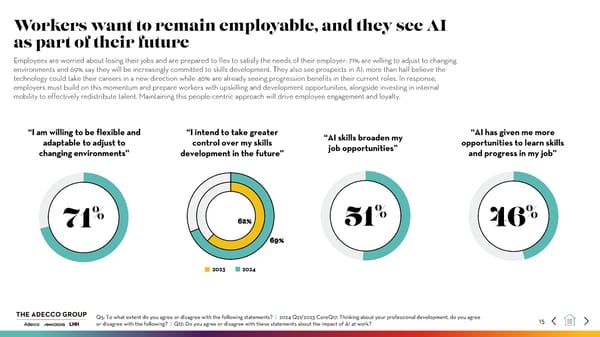
Recommendations Employers need Employees to carry out an honest are committed but appraisal of the future they are also looking of work and educate for opportunities, so workers about their employers should invest prospects in talent development as well as new technologies Workers are starting to see the true impact of AI. Employers must give them guidance on the changing nature of work and its opportunities 16
SECTION TWO Employers must upskill a generation of future-ready workers
Summary A minority group of ‘future- Future-ready workers are Companies must invest in ready workers’ is outperforming more likely than the average skills development and the rest. To create more employee to be guided in their progression planning if they of these workers, employers career growth by employers, who want to keep their most must recognise each see them as potential leaders. valuable employees. employee’s potential. 18
“AI will lead to a broader scope of work where one must think deeply and act independently.” Associate, Japan, Security 19
‘Future-ready workers’: still a small segment thatemployers must nurture and grow Our research has identified a minority group of employees who are equipped to navigate an uncertain workplace and maximise career opportunities as they emerge. This type of worker is adaptable and willing to be flexible with their career plans. They embrace new technologies and they have versatile skills. We call them the ‘future-ready workers’,* and they currently make up just 11% of the workforce. To create more of them, employers must recognise and support the potential of all workers. ‘Future-ready workers’ are: “I am willing to be flexible and adaptable “I am comfortable with the fact that my job could to adjust to changing environments” Adaptable change completely due to AI” 11% “AI has given me more opportunities to learn skills/progress in my job” “I proactively experiment with different “I have applied the ethical/responsible Tech Proactive ways of using AI at work” use of AI training to my work” savvy “I regularly invest my own time outside of the sample are “AI has made me more productive” of working hours to develop my skills” ‘future-ready workers’ *To qualify as a ‘future-ready worker’ respondents must select ‘agree’ or ‘strongly agree’ to all seven of the statements presented above, which were dispersed throughout the survey. 20
Whereare the future-ready workers? This premium talent is most likely to be found in India, China and the USA, and to work in the financial and professional services sector. They are predominantly mid-manager level, which means that if they are supported correctly they are well-positioned to inspire junior team members andcan help to increase the numbers of future-ready workers from the bottom up. Country Industry Seniority 1 2 3 1 Financial services, insurance, 1 Managers (56%) India China USA legal and professional services (19%) (14%) (13%) (32%) 2 2 Senior managers (25%) Consumer goods, FMCG, retail 4 and e-commerce, supply chain (18%) 3 Leaders(9%) Germany 3 (7%) Transportation, mobility and automotive (14%) 5 =3 Technology(14%) 4 Non-managers(8%) Australia (5%) 4 Manufacturing and logistics (11%) 5 Entry level (2%) *the proportion of future-ready workers that come from each country/industry/seniority band D1: In which country are you based? D6: In which sector do you work? | D10: Which of the following best describes your position or level within your company? 21 Full demographic breakdown of ‘future-ready workers’ available in the appendix
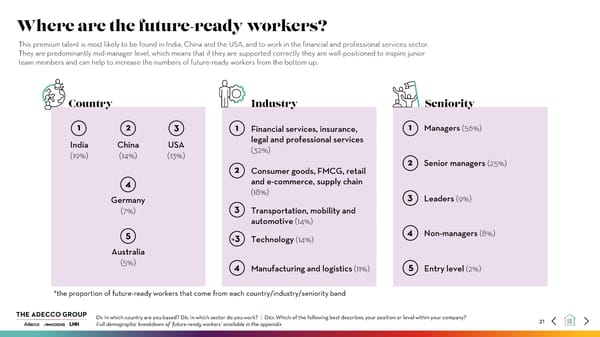
Future-ready workers are moulded by their employers Future-ready workers say their employers commit to helping them throughout their skills development journey. They are far more likely than the total sample to belong to companies that provide consistent, clear communication about workplace changes, and they are much more informed about progression opportunities. Employers that want to increase their number of future-ready workers must work more collaboratively with all employees to identify common goals and generate excitement about their prospects. How are employers building future-ready workers? 01 Assess 02 Communicate 03 Develop 04 Train Regularly assessing the Holding regular professional Working with employees to Investing effectively in suitability and relevance progression conversations to devise a personalised career developing employee skills, of current skills inform about areas of development development plan either through formal training and future opportunities or on-the job learning 95% 95% 93% 95% 58% 58% 51% 56% Future-ready workers Global average Q21: Thinking about your professional development, do you agree or disagree with the following? ‘My employer is…’ 22
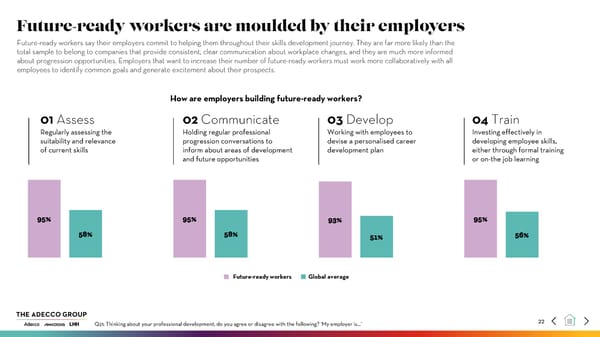
A future-ready worker will leave an employer that doesn't support their ambition... For future-ready workers, fair pay and development are non-negotiables. After salary, future-ready workers are leaving for better opportunities – 32% are pursuing jobs that will give them skills to become more employable in the future, compared with 23% of the global workforce. And 30% are looking for a job that invests more in upskilling and training, compared with 19% of the global workforce. Finally, future-ready workers prioritise upskilling over traditional career progression, suggesting they understand the value of non-linear career paths and adaptability. Future-ready workers want fair compensation and development opportunities I want a better salary 42% 51% I want a job with better work-life balance 32% 33% My career is not progressing in my current company 17% 27% - 10 points I am unhappy in my current job 18% 24% I want a job with remote-working opportunities 24% 28% I would like to move to a job that will give me skills to make me more employable in the future 23% 32% + 9 points I want a job with more flexibility regarding working schedules 22% 30% I am looking for/have been offered a better opportunity elsewhere 21% 30% My work is not fulfilling/meaningful 14% 20% I am worried about burnout or working too much 20% 18% I am looking for a job with more investment in upskilling/training 19% 30% + 11 points Global average Future-ready workers Q24: You said that you would like to leave your job in the next 12 months. Which of the following best describes why you would like to make this change? 23
But they will be loyal to an employer that makes them feel valued Future-ready workers are motivated to take advantage of training opportunities offered by their companies. And they are valued by their employers: 57% say they receive higher compensation than their peers. Employers that meet future-ready workers' expectations of skills development and compensation are rewarded with loyalty: 89% intend to stay with their company over the next 12 months. But employers that don’t could lose these high-value workers: nearly half of the future-ready workers say they could find new opportunities elsewhere within one month. Future-ready workers stay with employers while their needs are being met 21% 95% 38% 89% 47% 57% 64% 83% “I regularly participate in training “I am better paid than peers within my “I intend to stay in my job for the “I believe I could get a new job within provided by my employer” company or my industry” next 12 months” one month” Future-ready workers Global average Q21: Thinking about your professional development, do you agree or disagree with the following? | Q4: Do you feel your salary is in line with the salary your peers receive in your company or across your industry? | Q15: Thinking about your professional plans in the next 12 months, which of the following best applies to you? | Q16: How long do you think it would 24 take you to find a new job if you had to start searching for a job tomorrow?
Future-ready workers are the next generation of leaders Nearly 60% of business leaders surveyed in our previous research* see career development and leadership succession planning as important ways to close skills gaps within their companies, and future-ready workers are being manoeuvred into position. Most (92%) agree that their employers are investing in their long-term skills, while 95% say they’re being trained in leadership and soft skills. Further commitment to developing future-ready workers using the four steps set out above – assess, communicate, develop, and train – will keep the organisation adaptable. Future-ready workers are more likely to say They’re more likely to participate in And business leaders* agree that "skills gaps are that their employer is preparing them with leadership training or soft skills training best closed by improving career development long-term skills provided by their employer and leadership succession planning" 92% 95% 59% 50% 57% Future-ready workers Global average Q5: To what extent do you agree or disagree with the following statements? | Q21: Thinking about your professional development, do you agree or disagree with the following? 25 *The Adecco Group, April 2024, Leading Through the Great Disruption: Q14. To what extent do you agree with the following statements about skills and development?
Recommendations Organisations must align talent strategy Employers need with the fundamental to nurture their future shift to a skills-based leaders to fill skills gaps rather than a jobs- and lay the foundations based economy for a more adaptable workforce Employers can create more future- ready workers by working collaboratively with employees to implement long-term skills development plans 26
SECTION THREE Workers want internal mobility, but employers fail to see the value
Summary Are employees staying Workers want to see more because of the current climate Employers face significant talent professional development rather than their satisfaction gaps, but they’re failing to see the opportunities, but they say with their work prospects? If value in professional development. their employers’ employers don't invest in commitment is plateauing. training, they could lose their most valuable employees. 28
"I strongly believe that companies, whether small or large, should train their employees for the digital revolution that AI will be in the near future. Worker, Italy, Janitorial 29
Workers want to be upskilled, but businesses aren't doing it Company leaders* say they face challenges caused by skills shortages, and they appear to be overlooking the potential for internal talent to fill these gaps. This mentality is at odds with workers who are increasingly looking to be upskilled: 76% of employees (compared with 64% last year) say that companies should train existing employees for different roles before hiring external candidates. Company leaders are depending too much on buying talent – instead, they should take a balanced approach also building skills from within. Investing in upskilling and internal mobility will give organisations a competitive advantage, enabling them to successfully navigate change. Business leaders need to make more of existing talent opportunities While employees value internal mobility more and more % % 65 52 64% 76% of business leaders* agree But only half have 2023 2024 that skills shortages are having implemented strategies to of workers agree that companies should a moderate to significant encourage internal mobility train existing employees for different impact on their company roles before hiring external candidates *The Adecco Group, April 2024, Leading Through the Great Disruption: Q1: To what extent are the following megatrends impacting your company today? Talent scarcity or skills shortages. | Q8. In which of the categories listed are you taking significant initiatives to improve your talent strategy? - Piloting or have successfully implemented | Q26: To what 30 extent do you agree or disagree with the following statements about recruitment?
Business leaders must do more to maximisetheir existing talent Compared with 2023, a much bigger proportion of workers want to stay in their current job for the next year with no conditions: 49% compared with 35%. But the proportion who want to be upskilled in their current company has dropped significantly. Employer commitment to upskilling, meanwhile, is plateauing: from 2022 to 2023, employees were increasingly likely to say their company was preparing them with the skills needed for different roles, but over the past 12 months that progress has stalled. Does employees’ willingness to stay without conditions reflect the current climate, rather than their happiness about their longer-term prospects? The number of workers who want to stay without conditions Commitment to professional development is plateauing has increased by 14 points year on year 56% 58% 55% 56% 49% 50% 49% 35% 21% 22% 16% 9% I want to stay in my job I want to progress with I want to be upskilled for My company regularly assesses my skills My company is investing effectively in (with no conditions) my current a new job in my current developing my skills company/employer company 2023 2024 2022 2023 2024 Q15: Thinking about your professional plans in the next 12 months, which of the following best applies to you? | Q21: Thinking about your professional development, do you agree 31 or disagree with the following?
Workerswhose employers provide professional developmentare less likely to quit There's a clear correlation between workers who intend to stay with their employer for Some worker groups are better served when it comes to professional development. the next year and workers whose employers give them regular training, skills assessment White-collar workers, managers and workers with degrees are all more likely to have and career reviews. To retain talent and competitive advantage, organisations must invest regular professional performance reviews or discussions. in internal progression and upskilling. “I have regular performance discussions/professional progression I regularly take part in training provided by my 54% conversations with my employer to understand areas of development employer 67% and future opportunities” My employer regularly assesses the suitability 48% and relevance of my current skills (e.g. through 61% University degree 61% regular performance reviews) I have regular performance/progression 46% Vocational school/technical college 51% discussions with my employer to understand 61% Secondary school/equivalent or less 46% areas of development I regularly take part in training around 46% soft/leadership skills, provided by my employer 60% White-collar worker 61% My employer is investing effectively in 42% Blue-collar worker 43% developing my skills, either through formal 59% training or on-the-job learning My employer works with me to me devise a 38% Managers 67% personalised professional/career development 54% plan Non-managers 48% Entry level 41% Intend to quit in the next 12 months Intend to stay with employer for the next 12 months Q21: Thinking about your professional development, do you agree or disagree with the following? | Q21: Thinking about your professional development, do you agree or disagree 32 with the following?
Recommendations Companies should promote Employers must internal mobility, support all workers balancing their “build” in their development versus “buy” talent equally to maximise strategies their talent advantage Employers should continuously assess current and future skills needs and apply insights to workforce planning 33
SECTION FOUR AI impactreveals high-value human potential
Summary AI has become more embedded, Many workers now have more its impact in the workforce is capacity for creative or strategic Employers must do more to help measurable, and the productivity work, but they need better guidance workers feel confident, such as gains are clear. Workers say one to maximise this potential. Just 28% clearer support and advice. Only hour is the average daily time of those who are saving time say 25% of workers have completed saved by using AI. they spend that time on more training on how to use AI at work. creative work. 35
“AI will elevate the work that we Executive Assistants do. I'm not fearful that it will replace me. In fact, I use it often to make myself better! I love that I can increase the level of support I give to my executive, becoming more strategic and better positioned to help him succeed.” Executive Assistant, US, Electronics 36
Workforce AI is becoming part of the daily routine There has been a significant rise in the numbers of workers who use AI every day: from 31% in 2023 to 48% in 2024. The average time saved per day is one hour although a fifth of users said the technology was saving them as many as two hours a day. Generative AI (tools such as ChatGPT, Time saved per day by using AI Bard/Gemini, Copilot) No 1-15 15-30 40% time mins mins 37% 3% 8% 17% 32% 28% The average 24% 25% 30-45 45-60 1-2 time saved per mins mins hours day by using AI 19% 21% 20% is one hour 6% 8% 3-4 5+ Don’t hours hours know Occasionally Weekly Daily Hourly 5% 1% 4% 2023 2024 Q8: How often do you use GenAIat work? (Base: Those who use AI at work) | Q9: How much time do you save per day using AI? - Mean average calculation 37 (Base: Those who use AI at work)
AI is enabling creativity, but not enough workers are making the most of having extra time About three-quarters of workers say that AI is making them more productive every day. That time saving is helping some workers to unleash their human potential and improving their quality of life: nearly one-third of the people who are saving time using AI are doing more creative work, and about a quarter are doing more strategic thinking or gaining a better work-life balance. But not everyone is maximising the productivity gains: 35% are spending more time on the same workload or more mundane tasks.* So employees need practical, personalised guidance and on-the-job training in how they can make the most of AI's potential. Managers should lead by example here, and provide role-specific best practice guidelines for every level of the organisation. How workers are spending the time they save from using AI More time to check work's quality/accuracy 29% More creative work 28% Better work-life balance (i.e. taking more breaks or working less overtime) 27% More strategic thinking 26% More time to complete the same workload (no new tasks or activities) 23% More training/upskilling 22% 73% More time on personal activities/planning 21% More time collaborating with colleagues 19% More time on people management or mentoring tasks 18% of workers who use AI say it makes them more productive More mundane tasks/work that is less interesting 15% Attending more work-related events (i.e. networking) 14% More time searching for jobs/career opportunities 13% Q10: You said you have saved time using AI in your role. Which of the following areas have you been able to spend more time on? *Workers could select up to three answers | Q11: To 38 what extent do you agree/disagree with the following statements about the influence of AI at work? - AI has made me more productive (Base: Those who use AI at work)
The future-ready workers are getting more AI guidance and support from their employers, but it’s still not enough Future-ready workers receive more guidance on AI from their employers, which shows that better support is possible. But even in this more supported group, only 39% are instructed on the type of tasks they could use AI for within their role to save them time. With new use cases and tools emerging all the time, employers could be failing to provide their workforces with a solid foundation for future growth. Future-ready workers are getting more And these workersare more confident instruction from their employers in three areas: about usingAI 23% 19% What training you should complete to enhance your AI skills 40% 22% 56% What AI tools you should use 38% 22% What tasks you should use AI for in your role 39% "Nothing holds me back from using AI more" Future-ready workers Global average Q13: To what extent are you instructed on what to do by your employer/manager in the following areas relating to AI? | Q7: What holds you back from using AI more? 39
Workers have potential throughout their careers – employers must help them use it One-fifth of workers say they hold back from using AI because they haven’t received The proportion of workers who have completed training in how to apply AI at work drops guidance on how to use it properly. This is unsurprising when only one-quarter say drastically for junior and lower-paid workers. It's creating a big knowledge gap, so they’ve been trained in how to use AI at work. employers must make training available to all workers. Why workers hold back from using AI Employers need to invest in training for all workers It's not relevant to my job/role 29% 34% 34% There is no guidance on how to use it properly 22% Nothing holds me back from using AI more 19% 25% It will mean I speak to or interact less with 14% 20% other people at work 15% I don't trust AI 14% 13% 13% The data that it's based on is biased 12% I've run out of ideas how to streamline other 12% tasks with AI I can't access the technology 11% I don't have the time 8% I forget to use it 8% "I have completed training on how to apply AI at work" My company policy forbids the use of AI 8% Q7: What holds you back from using AI more? | Q11v2: To what extent do you agree/disagree with the following statements about the influence of AI? 40
Recommendations Employers need to provide Employers holistic AI training, must provide more including on-the-job direction to workers in guidance, inclusive the earlier stages of policy guidelines and their career to set upskilling them up for an adaptable future Free up workers’ time to focus on strategic and creative work that requires uniquely human skills: make this the goal of AI workflow integration 41
SECTION FIVE Build trust in AI to enable every employee to do their best work
Summary Seismic changes are happening in the Less than half of employees have Employees that are shown how to workplace, so looking after employee confidence in business leaders’ skills use AI responsibly and ethically apply mental health must be a priority for and knowledge to be able to those learnings in the workplace. companies. Workers who are understand the risks of AI adoption at This contributes to a culture of trust concerned about the impact of AI and work. And trust in AI in recruitment and transparency around new have been negatively affected by it are has fallen year-on-year, which suggests technologies and builds a foundation much more likely to have felt burned that workers increasingly value human for new ways of working. out in the past year. involvement in this area. 43
“Honestly, I prefer personalised attention from humans. No matter how advanced the technology, it cannot compare to the human touch we possess.” Associate, FMCG, Spain 44
Some employees' mental health is suffering as AI transforms workplaces Stress levels at work are persistently high: two in five workers have felt burnout in the past year, which is similar to the levels recorded in 2023 and 2022. This year, employees who feel vulnerable to AI (those who are concerned about the impact of AI and have been negatively affected by it) are significantly more likely to have felt burnout. They are also more likely to have had their physical health suffer as a result of working too hard – and to worry about experiencing burnout in the future. 40% I have felt burnout in the last 12 months from working too hard 62% 48% I worry that I will experience burnout in the future 67% 40% My physical health has suffered because of working too hard 63% Global average Workers who feel vulnerable to AI Workers who feel vulnerable to AI say that: • They are concerned by one or more of the following: the impact of AI, their longer-term job security and their short-term job security • AI has made them lose a job or has forced them to consider a profession change Q31: To what extent would you agree or disagree with these statements about wellbeing at work? 45
Employers must do more to make the future work for everyone As well as protecting workers' mental health from any impact of AI, employers must continue to create equitable environments that allow every employee to thrive. It's good to see that more workers now feel able to speak up at work and that more feel like they work in an inclusive and diverse environment. But only slightly over half say they have had diversity and inclusion training, and there’s been no improvement in the proportion who say their employer has got better at making employees feel safe. It's easy for me to participate at work (i.e. speaking up 71% in meetings or sharing my ideas) 64% Business leaders* themselves admit that there's work to do I feel that I work in an environment that's 68% inclusive and diverse 62% 55% % I have had training/advice on diversity and 47 inclusion at work 56% My employer does a better job of making people from 55% all backgrounds feel safe at work than it did Less than half of companies 12 months ago 56% have a well-developed, inclusive talent strategy 2024 2023 Q30: To what extent do you agree/disagree with the following statements about diversity and inclusion? | *The Adecco Group, April 2024, Leading Through the Great 46 Disruption: | Q18: How developed are the following areas of your company's social sustainability agenda relative to others in your industry?
Some workers worry that AI will harm their career prospects One of the elements of AI that’s causing the most anxiety for workers is its potential to disadvantage some groups' employment prospects more than others’. Among workers who don't trust AI with some aspects of recruitment, the most common reason is that it won’t be able to assess non-verbal cues in interviews: 52% say this. For workers who feel vulnerable to AI and say they don't trust it with some aspects of recruitment, one-fifth believe it will discriminate against them. What are the main reasons for your lack of trust? It won't be able to assess positive non-verbal cues that I 52% display in interviews 39% I don't understand how AI would recognise that I'm a good 38% candidate for the job 29% It will ignore my skills and/or experience 22% 22% The recruitment process won't be fair if some candidates 21% are using AI 24% I have concerns about what the technology will do with my 17% information 20% I do not want my data/personal information to be misused 16% 21% I'm unsure whether it has been regulated or approved for 13% use 15% 12% Global average I think it's likely to discriminate against me 19% Workers who feel vulnerable to AI Q28: You said you don't trust AI with some aspects of recruitment. What are the main reasons for your lack of trust? 47
Anxiety over AI means human input is increasingly valued Recruitment is one area where workers are increasingly seeking human input – 76% say they value the expertise of a recruiter to see potential in them, compared to 64% last year. At the same time, the number who trust in AI's ability to deliver a fair assessment of previous experience has fallen 10 points since last year. In previous research* only 43% of business leaders had confidence in their AI skills and knowledge to be able to understand the risks, so it's unsurprising that only 46% of workers say the same. Leaders must hold themselves accountable to skill themselves in AI first, to allow their workforce to believe that they can make informed decisions on how and where it should be used. Those who want a human to assess While those who trust Al to assess their experience is increasing their experience hasfallen sharply 76% 64% 55% 46% 45% 43% Workers Business leaders 2023 2024 “In a recruitment process I value the "I trust AI to assess the relevance of my Less than half of workers and less than half human expertise of a recruiter to see non-traditional experience that would of business leaders* respectively have potential in me beyond my skills and make me a good fit for a job" confidence in decision-makers’ previous experience” AI skills and knowledge Q26: To what extent do you agree or disagree with the following statements about recruitment? | Q27: To what extent do you/would you trust a potential employer's use of artificial intelligence (AI) in the following aspects of their recruitment process? | Q11: To what extent do you agree/disagree with the following statements about the influence of AI at work? - I am confident that my employer's management/leadership team have sufficient AI skills and knowledge to understand the risks and opportunities | *The Adecco Group, April 2024, Leading Through the Great Disruption: Q16. To what extent do 48 you agree with the following statements about your company's use of AI? - My company's leadership team have sufficient AI skills and knowledge to understand the risks and opportunities
When employers deliver AI training, employees use what they learn Organisations must urgently do more to embed an ethical and responsible approach to AI implementation, starting with putting ethical AI frameworks in place. Less than half of the business leaders in our previous research* said they had a framework in place for this, and less than a third of workers say they have completed training in ethical/responsible use of AI. But most of those who have completed training are applying it to their work, which shows that the investment pays off. Less than half of business leaders* Less than a third of workers have But those who have are applying say they have a framework in place completed training in the training to their work for using AI responsibly and ethically ethical/responsible use of AI % % % 49 34 79 *The Adecco Group, April 2024, Leading Through the Great Disruption: Q16. To what extent do you agree with the following statements about your company's use of AI? | Q11: To what extent do you agree/disagree with the following statements about the influence of AI at work? (Base: those whose company allows the use of AI / Those who have completed training on 49 ethnical/responsible use of AI)
Recommendations Employers urgently need to implement an AI ethical usage policy and Ensure all leaders training to increase are upskilled on AI workers' confidence in and are adopting the technology and new technology reduce anxiety Companies must ensure that AI-related policy and workforce planning consider inclusiveness, safety, transparency, privacy and accountability 50
SECTION SIX Recommendations for organisations
Recommendations for organisations Three ways to work through change Organisations must develop a workforce that is truly ready for AI’s disruptive power. Currently, only 11% of global workers are ‘future-ready’ workers, equipped to navigate an uncertain workplace. Employers must recognise and support the potential of all workers to become future-ready. Based on this year’s research, this is how your organisation can build a future-ready workforce that is: flexible and adaptable, adjusting to Adaptable changing environments approaching emerging technologies as an Tech Proactive proactively experimenting with new opportunity to learn skills and progress savvy technologies and upskilling for the future 52
1 Invest in talent development as well as technology through four stages… 2 to build a future-ready Assess Communicate Develop Train workforce that is… • Employers need to carry out an honest • Organisations must clearly and transparently • Align with the fundamental shift to a skills-based • Teach adaptability through regular training Adaptable appraisal of the future of work and educate communicate the impacts of emerging economy and away from a jobs-based one and development workers about their prospects technology on the company and its workforce • Provide transparent guidance on skills needs for • Provide regular upskilling – not just technical Workers who are enabled to be flexible and • Empower managers with data-driven tools to to support employees through times of next career steps skills but also human skills. adaptable to adjust to changing environments understand, assess and predict skills needs uncertainty and plan the talent pipeline. A shared skills • Coach leaders to be able to engage and • Match individuals’ skills to in-demand future • Make sure workers understand therelevance taxonomy is vital here. motivate all levels of the workforce through careers and embed these insights into of upskilling programmes to their role and change personalised career development plans progression plan • Continuously assess current and future skills • Make training formal and informal, multi- needs and apply insights to workforce • Educate workers in the importance and value modular and continuous planning of transferable skills • Ensure effective collaboration across the • Adopt a people-centric approach to • Free up workers’ time to focus on strategic • Provide on-the-job training to ensure workers Tech savvy entire C-Suite to connect business strategy technology transformation and clearly and creative work that requires uniquely apply digital and data literacy to their daily and HR strategy communicate this commitment to the human skills: make this the goal of AI tasks and activities Workers who approach emerging • Evaluate existing access to tools and workforce workflow integration • Develop responsible AI frameworks and technologies as an opportunity to learn skills technology to highlight and address any • Promote a culture of growth and resilience • Ensure that there are regular personalised guidance to ensure workers use AI and progress inequality among workers career conversations, powered by data- appropriately and effectively and increase trust • Make sure AI-related policy and workforce • Ensure leaders address concerns driven tools, for all workers in the technology planning consider inclusiveness, safety, transparently and positively to create more • Promote upskilling and internal mobility to • Develop a responsible AI training programme transparency, privacy and accountability trust, openness and advocacy maintain a sustainable balance between • Ensure all leaders are upskilled on AI and are building and buying talent adopting new technology • Identify and tackle any issues of talent • Organisations should proactively inform the • Prioritise skills-based hiring and ensure roles • Create an organisational and leadership Proactive hoarding across teams and departments workforce about the impacts of emerging are skills-defined culture that promotes continuous upskilling • Match workers’ skills to the technology on the business to maintain • Celebrate transferable skills by consistently and empowers workers to take ownership of Workers who proactively experiment with organisation'sneeds and to their own career engagement and trust onboarding workers from different industries their own training new ways of working and commit to plans • Educate managers to challenge traditional and backgrounds with confidence and • Recognise your company’s need for human upskilling themselves for the future career paths and employment models conviction skills and make them a core part of the talent • Create an organisational culture that • Create non-linear skills-based career lifecycle – from hiring to progression. promotes internal mobility and non-linear pathways for all workers • Leaders should act as a role model, pathways developing their own human skills with coaching, training and leadership development. 53
APPENDIX Demographic, country and industry focus
Demographics & definitions 55
Demographics and definitions Age Sample Highest level of academic education achieved Sample 18-24 3,293 Secondary school/equivalent or less 4,635 25-34 9,907 Vocational school/technical college 7,051 35-49 12,083 University degree 14,628 50-60 9,717 Postgraduate degree 8,482 I prefer not to say 204 Gender Sample Man 17,344 Woman 17,560 Non-binary 75 Other/ Prefer not to say 21 56
Demographics and definitions Country Sample Industry Sample Argentina 1000 Aerospace and defence 595 Australia 2000 Automotive 1376 Belgium 500 Banking 2204 Brazil 1000 Clean technology (tech the reduces negative 252 Canada 1025 environmental impacts through significant energy China 2000 efficiency improvements) Denmark 385 Consulting 1109 Finland 505 Consumer goods (including Fast moving consumer goods 1969 (FMCG)) France 2025 Energy and utilities 1107 Germany 2025 Financial services 1939 Greece 500 Healthcare (including medical and pharmaceuticals) 4192 India 2030 Insurance 856 Italy 2025 Legal 798 Japan 2010 Life sciences 503 Mexico 1000 Logistics 1047 Netherlands 500 Manufacturing 4639 Norway 505 Professional services 3369 Poland 505 Retail/E-commerce 3684 Portugal 1000 Supply chain 627 Romania 500 Technology 3277 Slovenia 360 Transportation and mobility 1457 Spain 2025 Sweden 505 Switzerland 1005 Turkey 505 UK 2030 USA 5530 57
Demographics and definitions Level of seniority Definition Sample ‘Which of the following best describes your position or level within your company?’ Leaders (total) ‘Senior executive level (CEO, President, etc.)’ 2,011 Senior managers ‘Executive level (General Manager, Executive Vice President, Executive Director, etc.)’ 1,303 ‘Upper-level management (Senior Vice President, Vice President, Senior Director, etc.)’ 2,038 Senior managers (total) 3,341 Managers ‘Mid-level management (Director, Senior Manager, etc.)’ 8,977 ‘Lower-level management (Supervisor, Associate Manager, etc.)’ 6,509 Managers (total) 15,486 Non-managers (total) ‘Experienced (Non-manager)’ 10,556 Entry level ‘Entry level’ 2,424 Other/prefer not to say ‘Other’ OR ‘Don’t know/prefer not to say’ 1,182 Entry level (total) 3,606 Income level Definition Sample ‘What is your total personal income from all sources, before taxes?’ High 15,852 Middle Low-, middle-and high-income bands were calculated on a country-by-country basis and based on macroeconomic 13,903 secondary data Low 4,495 Prefer not to answer ‘prefer not to answer’ 750 58
Demographics and definitions Smart Industry worker Definition Sample Those who work in design, development and/or engineering in the following roles: consultant/advisory, customer Smart Industry workers service, engineering, equipment operation/maintenance, healthcare professional, IT, operations, product management, 7,115 quality control, R&D, Risk and compliance, security, supply chain. Definition Agency worker ‘Regarding agencies / staffing agencies, which of the following best applies to you? Sample By agencies / staffing agencies, we mean a company that employs you and pays you but places you to work in another company.’ Agency worker ‘I found my current job through an agency/staffing agency’ 13,190 Non-agency worker ‘I did not find my current job through an agency/staffing agency’ 21,810 Blue-collar vs White-collar Definition Sample ‘Which of the following best describes your current role?’ Blue-collar ‘Manual labour or skilled trades (e.g., construction, manufacturing, plumbing)’ 4,393 White-collar ‘Professional, office-based role’ or ‘Administrative or office-based (e.g., clerical, administrative assistant)’ 29,259 Other Respondents who work in service-oriented or caregiving professions, such as nursing, teaching and retail 1,348 59
Future-ready workers Age Sample Highest level of academic education achieved Sample 18-24 210 Secondary school/equivalent or less 154 25-34 821 Vocational school/technical college 284 35-49 1,359 University degree 1,531 50-60 1,331 Postgraduate degree 1,749 Other/prefer not to say 3 Gender Sample Man 2,080 Woman 1,631 Non-binary 10 60
Demographics and definitions Country Sample Industry Sample Argentina 83 Aerospace and defence 63 Australia 180 Automotive 186 Belgium 118 Banking 438 Brazil 136 Clean technology (tech the reduces negative environmental impacts through 30 Canada 68 significant energy efficiency improvements) China 504 Consulting 114 Denmark 44 Consumer goods (including Fast moving consumer goods (FMCG)) 81 Finland 13 Energy and utilities 124 France 160 Financial services 297 Germany 267 Healthcare (including medical and pharmaceuticals) 174 Greece 24 Insurance 101 India 719 Legal 41 Italy 96 Life sciences 34 Japan 31 Logistics 87 Mexico 94 Manufacturing 326 Netherlands 18 Professional services 200 Norway 47 Retail/E-commerce 439 Poland 29 Supply chain 137 Portugal 31 Technology 513 Romania 41 Transportation and mobility 336 Slovenia 15 Spain 85 Sweden 78 Switzerland 139 Turkey 104 UK 121 USA 476 61
Demographics and definitions Level of seniority Definition Sample ‘Which of the following best describes your position or level within your company?’ Leaders (total) ‘Senior executive level (CEO, President, etc.)’ 353 Senior managers ‘Executive level (General Manager, Executive Vice President, Executive Director, etc.)’ 457 ‘Upper-level management (Senior Vice President, Vice President, Senior Director, etc.)’ 455 Senior managers (total) 912 Managers ‘Mid-level management (Director, Senior Manager, etc.)’ 1,399 ‘Lower-level management (Supervisor, Associate Manager, etc.)’ 701 Managers (total) 2,100 Non-managers (total) ‘Experienced (Non-manager)’ 283 Entry level ‘Entry level’ 54 Other/prefer not to say ‘Other’ OR ‘Don’t know/prefer not to say’ 19 Entry level (total) 73 Income level Definition Sample ‘What is your total personal income from all sources, before taxes?’ High 2,728 Middle Low-, middle-and high-income bands were calculated on a country-by-country basis and based on macroeconomic 815 secondary data Low 161 Prefer not to answer ‘prefer not to answer’ 17 62
Demographics and definitions Smart Industry worker Definition Sample Those who work in design, development and/or engineering in the following roles: consultant/advisory, customer Smart Industry workers service, engineering, equipment operation/maintenance, healthcare professional, IT, operations, product management, 967 quality control, R&D, Risk and compliance, security, supply chain. Definition Agency worker ‘Regarding agencies / staffing agencies, which of the following best applies to you? Sample By agencies / staffing agencies, we mean a company that employs you and pays you but places you to work in another company.’ Agency worker ‘I found my current job through an agency/staffing agency’ 2,654 Non-agency worker ‘I did not find my current job through an agency/staffing agency’ 1,067 Blue-collar vs White-collar Definition Sample ‘Which of the following best describes your current role?’ Blue-collar ‘Manual labour or skilled trades (e.g., construction, manufacturing, plumbing)’ 111 White-collar ‘Professional, office-based role’ or ‘Administrative or office-based (e.g., clerical, administrative assistant)’ 3,572 Other Respondents who work in service-oriented or caregiving professions, such as nursing, teaching and retail 38 63
Qualitative quotes from global workers The quotes shared throughout this report are excerpts from qualitative research conducted by the Adecco Group in June and July 2024. 1,443 workers from nine countries responded to an online survey of open-text questions investigating the impact of AI on their work. Country Sample Chile 15 Germany 3 Italy 331 Japan 150 Mexico 1 Peru 74 Spain 633 UK 14 USA 222 64
Key findings by country 65
Employers have a responsibility to prepare their workers (1/3) Global finding: 40% worry about long-term job security % of workers who are concerned about long-term job security 51% 50% 49% 48% 47% 47% 46% 45% 44% 42% 42% 41% 41% 41% 40% 40% 40% 40% 40% 39% 39% 39% 37% 34% 32% 32% 30% 30% 66
Employers have a responsibility to prepare their workers (2/3) Global finding: 83% plan to stay with their current employer % of workers who plan to stay with their employer over the next 12 months 94% 88% 88% 85% 85% 84% 84% 83% 82% 82% 81% 81% 81% 81% 81% 81% 81% 80% 80% 80% 80% 79% 79% 79% 79% 78% 78% 75% 67
Employers have a responsibility to prepare their workers (3/3) Global finding: 13% have lost their jobs because of AI 37% % of workers who agree that ‘AI has made me lose my job’ 28% 27% 26% 20% 19% 19% 19% 17% 17% 17% 16% 14% 14% 13% 13% 13% 12% 10% 9% 9% 8% 8% 7% 6% 5% 4% 4% 68
Employers must upskill a generation of future-ready talent (1/3) Global finding: 11% of the global sample are ‘future-ready workers’ % of country that are ‘future-ready workers’ 35% 25% 24% 21% 15% 14% 14% 13% 11% 11% 9% 9% 9% 9% 8% 8% 8% 7% 6% 6% 5% 5% 4% 4% 4% 3% 3% 2% 69
Employers must upskill a generation of future-ready talent (2/3) Global finding: 93% of future-ready workers are given a personalised development plan from their employer (vs 51% of all workers) % of country’s ‘future-ready workers’ that agree ‘My employer works with me 99% to devise a personalised professional/career development plan’ 99% 97% 96% 95% 95% 94% 94% 94% 93% 93% 93% 91% 91% 90% 89% 85% 84% 83% *countries where the sample size of ‘future-ready workers’ is less than 50 are not included 70
Employers must upskill a generation of future-ready talent (3/3) Global finding: 95% of future-ready workers frequently participate in leadership training provided by their employer (vs 57% of all workers) % of country’s ‘future-ready workers’ that agree ‘I regularly take part in training around soft/leadership skills, provided by my employer’ 99% 98% 97% 97% 97% 97% 97% 96% 96% 95% 94% 94% 94% 94% 93% 93% 92% 91% 90% 71
Workers want internal mobility, but employers fail to see the value (1/2) Global finding: 76% say companies should train existing employees for different roles across the organisation before hiring external candidates % of workers who agree that ‘Companies should train/upskill/develop existing employees for different roles across the organisation before hiring external candidates’ 87% 86% 85% 85% 82% 82% 82% 81% 80% 79% 78% 78% 78% 77% 76% 76% 76% 76% 76% 75% 74% 74% 73% 72% 71% 71% 68% 52% 72
Workers want internal mobility, but employers fail to see the value (2/2) Global finding: 9% plan to stay to be reskilled for a job at their company % of workers who say that ‘I want to be upskilled/reskilled for a new job in my current company’ best 17% applies to them when thinking about their professional plans in the next 12 months 15% 14% 13% 12% 12% 11% 11% 11% 11% 11% 10% 10% 10% 10% 10% 9% 9% 9% 8% 8% 7% 7% 7% 7% 6% 6% 6% 73
AI impact reveals high-value human potential (1/3) Global finding: 59 minutes is the average daily time saved from using AI Mean average (minutes) daily time saved as a result of using AI 78 70 67 66 65 64 59 59 57 57 56 56 56 54 54 54 53 53 51 51 50 48 48 46 43 42 40 37 74
AI impact reveals high-value human potential (2/3) Global finding: 28% of those saving time using AI are spending it on more creative work % of workers who say that they have been able to spend time on ‘more creative work’ 43% 42% because they have saved time using AI 39% 36% 35% 35% 32% 31% 31% 30% 30% 28% 28% 28% 27% 27% 26% 26% 26% 26% 26% 25% 25% 25% 24% 24% 23% 22% 75
AI impact reveals high-value human potential (3/3) Global finding: Only 25% have completed training on how to apply AI at work % of workers who agree that ‘I have completed training on how to apply AI at work’ 44% 40% 39% 37% 36% 32% 31% 30% 29% 29% 27% 26% 26% 26% 25% 24% 23% 23% 23% 22% 20% 20% 18% 18% 16% 15% 14% 10% 76
Build trust in AI to enableevery employee todo their best work (1/3) Global finding: 40% have felt burnout in the last 12 months from working too hard % of workers who agree that ‘I have felt burnout in the last 12 months from working too hard’ 60% 55% 54% 52% 50% 49% 48% 48% 48% 47% 47% 46% 45% 45% 44% 43% 43% 42% 41% 40% 37% 35% 34% 29% 27% 24% 23% 20% 77
Build trust in AI to enableevery employee todo their best work (2/3) Global finding: 46% have confidence in leaders' AI skills and knowledge to be able to understand the risks of AI adoption at work % of workers who agree that ‘I am confident that my employer’s management/leadership team have sufficient AI skills and knowledge to understand the risks and opportunities’ 76% 62% 59% 58% 57% 57% 56% 54% 53% 52% 49% 48% 48% 46% 45% 45% 44% 42% 42% 41% 41% 39% 38% 37% 36% 36% 35% 22% 78
Build trust in AI to enableevery employee todo their best work (3/3) Global finding: 76% value the human expertise of a recruiter to see potential in them beyond their skills and experience % of workers who agree that ‘In a recruitment process I value the human expertise of a recruiter to see potential in me beyond my skills and previous experience’ 87% 86% 84% 83% 82% 82% 82% 81% 81% 80% 80% 79% 78% 78% 78% 78% 78% 77% 77% 76% 76% 76% 76% 76% 74% 74% 70% 38% 79
Key findings by industry 80
Employers have a responsibility to prepare their workers (1/3) Global finding: 40% worry about long-term job security % of workers who are concerned about long-term job security 49% 44% 41% 40% 40% 39% 38% 37% 36% Aerospace and Technology Financial services, Global average Manufacturing and Consumer goods, Life sciences and Transportation, Energy, clean tech defence insurance, legal and logistics FMCG, retail and e- healthcare mobility and and utilities professional commerce, supply automotive services chain 81
Employers have a responsibility to prepare their workers (2/3) Global finding: 83% plan to stay with their current employer % of workers who plan to stay with their employer over the next 12 months 90% 86% 85% 84% 83% 83% 81% 81% 80% Aerospace and Manufacturing and Technology Energy, clean tech Global average Transportation, Life sciences and Financial services, Consumer goods, defence logistics and utilities mobility and healthcare insurance, legal and FMCG, retail and e- automotive professional commerce, supply services chain 82
Employers have a responsibility to prepare their workers (3/3) Global finding: 13% have lost their jobs because of AI % of workers who agree that ‘AI has made me lose my job’ 21% 17% 15% 13% 13% 12% 12% 10% 7% Transportation, Financial services, Aerospace and Consumer goods, Global average Energy, clean tech Technology Manufacturing and Life sciences and mobility and insurance, legal and defence FMCG, retail and e- and utilities logistics healthcare automotive professional commerce, supply services chain 83
Employers must upskill a generation of future-ready talent (1/3) Global finding: 11% of the global sample are ‘future-ready workers’ % of industry group that are ‘future-ready workers’ 18% 16% 12% 11% 11% 11% 10% 7% 4% Transportation, Technology Financial services, Global average Energy, clean tech Aerospace and Consumer goods, Manufacturing and Life sciences and mobility and insurance, legal and and utilities defence FMCG, retail and e- logistics healthcare automotive professional commerce, supply services chain 84
Employers must upskill a generation of future-ready talent (2/3) Global finding: 93% of future-ready workers are given a personalised development plan from their employer (vs 51% of all workers) % of industry’s ‘future-ready workers’ that agree ‘My employer works with me 97% to devise a personalised professional/career development plan’ 95% 94% 94% 93% 93% 92% 91% 90% Transportation, Aerospace and Consumer goods, Financial services, Global average Technology, Media Energy, clean tech Life sciences and Manufacturing and mobility and defence FMCG, retail and e-insurance, legal and and Telecoms and utilities healthcare logistics automotive commerce, supply professional chain services 85
Employers must upskill a generation of future-ready talent (3/3) Global finding: 95% of future-ready workers frequently participate in leadership training provided by their employer (vs 57% of all workers) % of industry’s ‘future-ready workers’ that agree ‘I regularly take part in training around soft/leadership skills, provided by my employer’ 97% 97% 96% 96% 95% 95% 95% 94% 93% Transportation, Aerospace and Financial services, Manufacturing and Grand Total Consumer goods, Energy, clean tech Technology, Media Life sciences and mobility and defence insurance, legal and logistics FMCG, retail and e- and utilities and Telecoms healthcare automotive professional commerce, supply services chain 86
Workers want internal mobility, but employers fail to see the value (1/2) Global finding: 76% say companies should train existing employees for different roles across the organisation before hiring external candidates % of workers who agree that ‘Companies should train/upskill/develop existing 81% employees for different roles across the organisation before hiring external candidates’ 79% 78% 77% 77% 76% 76% 75% 71% Aerospace and Technology Financial services, Transportation, Consumer goods, Life sciences and Global average Energy, clean tech Manufacturing and defence insurance, legal and mobility and FMCG, retail and e- healthcare and utilities logistics professional automotive commerce, supply services chain 87
Workers want internal mobility, but employers fail to see the value (2/2) Global finding: 9% plan to stay to be reskilled for a job at their company % of workers who say that ‘I want to be upskilled/reskilled for a new job in my current company’ best applies to them when thinking about their professional plans in the next 12 months 11% 11% 9% 9% 9% 8% 7% 7% 7% Technology Financial services, Consumer goods, Global average Manufacturing and Transportation, Life sciences and Energy, clean tech Aerospace and insurance, legal and FMCG, retail and e- logistics mobility and healthcare and utilities defence professional commerce, supply automotive services chain 88
AI impact reveals high-value human potential (1/3) Global finding: 59 minutes is the average daily time saved from using AI 75 Mean average (minutes) daily time saved as a result of using AI 66 63 59 57 56 56 53 52 Energy, clean tech Technology Manufacturing and Global average Transportation, Consumer goods, Financial services, Life sciences and Aerospace and and utilities logistics mobility and FMCG, retail and e-insurance, legal and healthcare defence automotive commerce, supply professional chain services 89
AI impact reveals high-value human potential (2/3) Global finding: 28% of those saving time using AI are spending it on more creative work % of workers who say that they have been able to spend more time on 33% ‘more creative work’ because they have saved time using AI 30% 30% 28% 28% 27% 24% 23% 22% Technology Manufacturing and Financial services, Global average Aerospace and Consumer goods, Life sciences and Energy, clean tech Transportation, logistics insurance, legal and defence FMCG, retail and e- healthcare and utilities mobility and professional commerce, supply automotive services chain 90
AI impact reveals high-value human potential (3/3) Global finding: Only 25% have completed training on how to apply AI at work % of workers who agree that ‘I have completed training on how to apply AI at work’ 39% 35% 28% 27% 26% 25% 24% 22% 16% Aerospace and Technology Energy, clean tech Financial services, Consumer goods, Global average Transportation, Manufacturing and Life sciences and defence and utilities insurance, legal and FMCG, retail and e- mobility and logistics healthcare professional commerce, supply automotive services chain 91
Build trust in AI to enableevery employee todo their best work (1/3) Global finding: 40% have felt burnout in the last 12 months from working too hard % of workers who agree that ‘I have felt burnout in the last 12 months from working too hard’ 44% 44% 43% 43% 40% 37% 37% 33% 31% Life sciences and Transportation, Financial services, Consumer goods, Global average Technology Energy, clean tech Aerospace and Manufacturing and healthcare mobility and insurance, legal and FMCG, retail and e- and utilities defence logistics automotive professional commerce, supply services chain 92
Build trust in AI to enableevery employee todo their best work (2/3) Global finding: 46% have confidence in leaders' AI skills and knowledge to be able to understand the risks of AI adoption at work % of workers who agree that ‘I am confident that my employer’s management/leadership team have sufficient AI skills and knowledge to understand the risks and opportunities’ 56% 50% 49% 48% 46% 46% 46% 44% 35% Technology Transportation, Financial services, Energy, clean tech Aerospace and Consumer goods, Global average Manufacturing and Life sciences and mobility and insurance, legal and and utilities defence FMCG, retail and e- logistics healthcare automotive professional commerce, supply services chain 93
Build trust in AI to enableevery employee todo their best work (3/3) Global finding: 76% value the human expertise of a recruiter to see potential in them beyond their skills and experience % of workers who agree that ‘In a recruitment process I value the human expertise of a recruiter to see potential in me beyond my skills and previous experience’ 79% 79% 78% 77% 77% 77% 76% 76% 70% Aerospace and Technology Financial services, Life sciences and Consumer goods, Transportation, Global average Energy, clean tech Manufacturing and defence insurance, legal and healthcare FMCG, retail and e- mobility and and utilities logistics professional commerce, supply automotive services chain 94
For media enquiries, please contact: [email protected] www.adeccogroup.com


